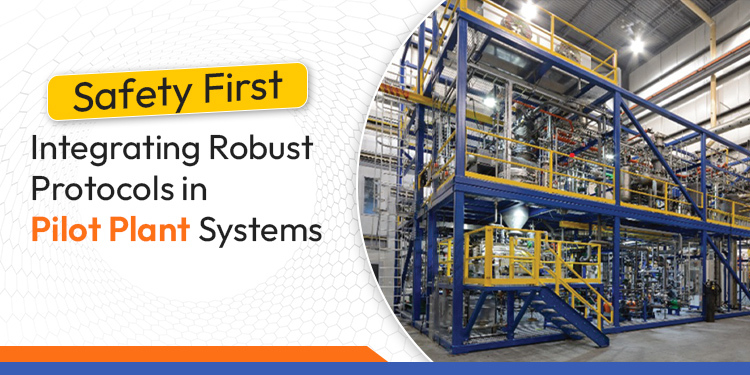Premier Pilot Plant People

Safety First: Integrating Robust Protocols in Pilot Plant Systems
Safety First: Integrating Robust Protocols in Pilot Plant Systems
Pilot plants are critical facilities for testing and validating production processes before scaling up to full production. Given the complexity and potential hazards associated with pilot-scale operations, ensuring safety is essential. The integration of comprehensive safety protocols in pilot plant systems is a foundational requirement for maintaining operational integrity and protecting personnel. The purpose of this blog is to provide key safety protocols, focusing on risk management, emergency response, safety equipment, personnel training, and compliance with regulatory standards.1. Identifying and Managing Hazards in Pilot Plants
The first step in ensuring the safety of a pilot plant is identifying potential hazards that may arise during operations. Hazards can be broadly categorized as:- Inherent Hazards: These are associated with the materials and chemicals used in the process. For example, flammable, toxic, or reactive chemicals pose risks during handling or processing.
- Operational Hazards: These are related to plant operations, such as equipment malfunction, human error, and insufficient maintenance.
2. Conducting Risk Assessments
Once hazards have been identified, a risk assessment must be carried out to evaluate the likelihood and potential severity of each risk. The steps in a typical risk assessment include:- Risk Identification: Identify both safety hazards and potential operational risks present in the plant.
- Risk Evaluation: Determine the severity of potential consequences from each identified risk and assess their likelihood.
- Risk Control: Implement control measures such as process safety management, regular maintenance, and emergency protocols to manage risks effectively.
3. Establishing Emergency Response Plans (ERP)
Despite preventive measures, emergencies may still occur. Pilot plants must have a well-established Emergency Response Plan (ERP) to address incidents such as fires, chemical spills, or explosions. Key components of an ERP include:- Emergency Contacts: A list of contacts, including plant managers, safety officers, and local emergency services.
- Evacuation Procedures: Marked evacuation routes and assembly points, ensuring all employees are aware of the procedures.
- Containment Systems: Procedures for containing chemical spills or gas releases.
- Training: Regular emergency drills should be conducted to ensure that all personnel are prepared to act swiftly in an emergency.
4. Safety Equipment and Systems
Proper safety equipment is essential for mitigating risks and protecting personnel. A pilot plant must be equipped with the following:- Personal Protective Equipment (PPE): Depending on the hazards present, this may include gloves, goggles, respirators, and flame-resistant clothing.
- Fire Suppression Systems: Fire extinguishers, sprinklers, and fire blankets should be readily available.
- Gas Detection and Ventilation Systems: Systems to monitor and maintain safe air quality levels in areas where hazardous gases are used.
- Emergency Shut-off Systems: Equipment that can immediately stop operations in the event of a malfunction or hazardous situation.
5. Training and Competency of Personnel
Human error remains a significant cause of accidents in pilot plants. Comprehensive training programs are essential to ensure that all personnel are competent in recognizing hazards, responding to emergencies, and using safety equipment properly. A successful training program should include:- Initial Safety Induction: A safety induction for all new employees, covering plant-specific risks and safety measures.
- Ongoing Safety Drills: Regular drills that simulate emergencies to ensure employees can respond effectively.
- Job-Specific Training: Employees should receive specialized training based on the machinery and chemicals they work with.
- Evaluation: Ongoing assessments of employees’ understanding of safety protocols and the effectiveness of training programs.
6. Regulatory Compliance
Pilot plants must adhere to national and international safety regulations that govern workplace safety, environmental protection, and worker health. Some of the key regulatory bodies include:- OSHA (Occupational Safety and Health Administration) in the U.S.
- REACH (Registration, Evaluation, Authorization, and Restriction of Chemicals) in the European Union
- The Chemical Safety Board (CSB) for incident investigations
7. Continuous Improvement: Audits and Reviews
Safety is not a one-time effort. Continuous monitoring, audits, and reviews should be integrated into the plant’s operational culture to identify areas for improvement. This process involves:- Regular Audits: Safety audits are conducted by both internal and external experts to assess the effectiveness of safety protocols.
- Incident Investigations: Thorough investigations of accidents or near-misses to identify the root causes and implement corrective actions.
- Employee Feedback: Encouraging employees to report safety concerns and suggestions for improving protocols.
Conclusion
The implementation of comprehensive safety protocols in pilot plants is essential for ensuring the well-being of workers, maintaining operational efficiency, and meeting regulatory requirements. By identifying and managing hazards, conducting regular risk assessments, establishing effective emergency response plans, and providing ongoing training, pilot plants can mitigate risks and operate safely. Incorporating continuous improvement practices through audits and reviews ensures that the plant’s safety culture evolves in line with changing conditions. Prioritizing safety across all operational aspects of a pilot plant not only helps prevent accidents but also contributes to the successful scaling up of production processes.Get in Touch
You will be amazed as how partnering with us becomes a game changer in your quest for R&D glory.

 Call Us
Call Us